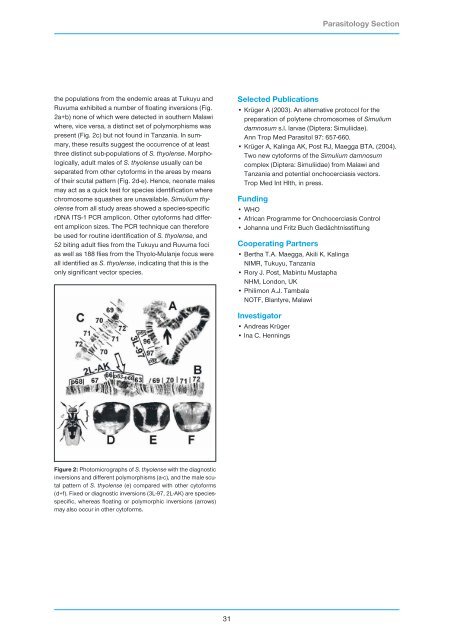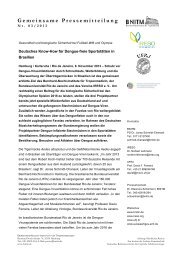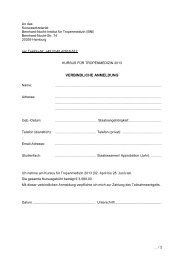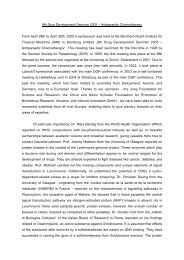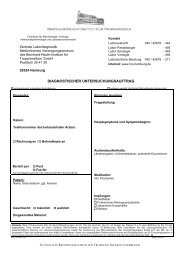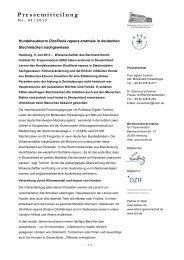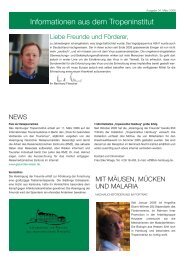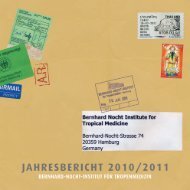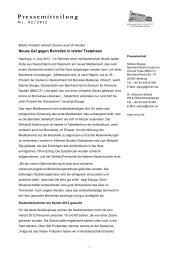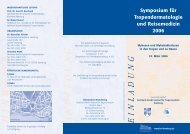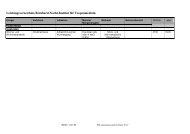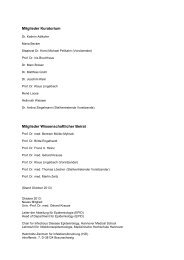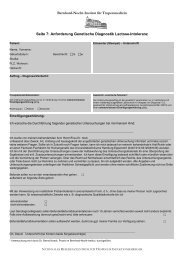Research Group Heussler (Malaria I) - Bernhard-Nocht-Institut für ...
Research Group Heussler (Malaria I) - Bernhard-Nocht-Institut für ...
Research Group Heussler (Malaria I) - Bernhard-Nocht-Institut für ...
You also want an ePaper? Increase the reach of your titles
YUMPU automatically turns print PDFs into web optimized ePapers that Google loves.
the populations from the endemic areas at Tukuyu and<br />
Ruvuma exhibited a number of floating inversions (Fig.<br />
2a+b) none of which were detected in southern Malawi<br />
where, vice versa, a distinct set of polymorphisms was<br />
present (Fig. 2c) but not found in Tanzania. In summary,<br />
these results suggest the occurrence of at least<br />
three distinct sub-populations of S. thyolense. Morphologically,<br />
adult males of S. thyolense usually can be<br />
separated from other cytoforms in the areas by means<br />
of their scutal pattern (Fig. 2d-e). Hence, neonate males<br />
may act as a quick test for species identification where<br />
chromosome squashes are unavailable. Simulium thyolense<br />
from all study areas showed a species-specific<br />
rDNA ITS-1 PCR amplicon. Other cytoforms had different<br />
amplicon sizes. The PCR technique can therefore<br />
be used for routine identification of S. thyolense, and<br />
52 biting adult flies from the Tukuyu and Ruvuma foci<br />
as well as 188 flies from the Thyolo-Mulanje focus were<br />
all identified as S. thyolense, indicating that this is the<br />
only significant vector species.<br />
Figure 2: Photomicrographs of S. thyolense with the diagnostic<br />
inversions and different polymorphisms (a-c), and the male scutal<br />
pattern of S. thyolense (e) compared with other cytoforms<br />
(d+f). Fixed or diagnostic inversions (3L-97, 2L-AK) are speciesspecific,<br />
whereas floating or polymorphic inversions (arrows)<br />
may also occur in other cytoforms.<br />
31<br />
Selected Publications<br />
• Krüger A (2003). An alternative protocol for the<br />
preparation of polytene chromosomes of Simulium<br />
damnosum s.l. larvae (Diptera: Simuliidae).<br />
Ann Trop Med Parasitol 97: 657-660.<br />
• Krüger A, Kalinga AK, Post RJ, Maegga BTA. (2004).<br />
Two new cytoforms of the Simulium damnosum<br />
complex (Diptera: Simuliidae) from Malawi and<br />
Tanzania and potential onchocerciasis vectors.<br />
Trop Med Int Hlth, in press.<br />
Funding<br />
• WHO<br />
• African Programme for Onchocerciasis Control<br />
• Johanna und Fritz Buch Gedächtnisstiftung<br />
Cooperating Partners<br />
• Bertha T.A. Maegga, Akili K. Kalinga<br />
NIMR, Tukuyu, Tanzania<br />
• Rory J. Post, Mabintu Mustapha<br />
NHM, London, UK<br />
• Philimon A.J. Tambala<br />
NOTF, Blantyre, Malawi<br />
Investigator<br />
• Andreas Krüger<br />
• Ina C. Hennings<br />
Parasitology Section


